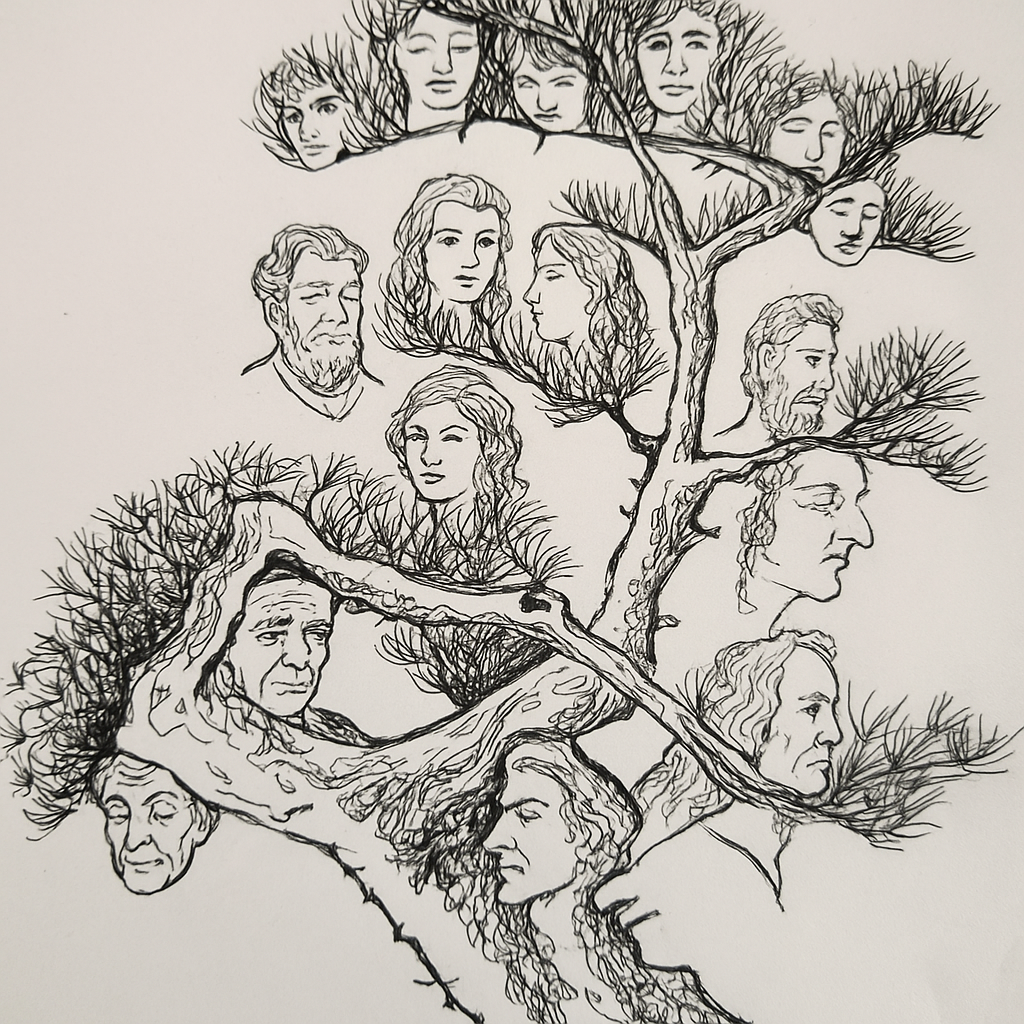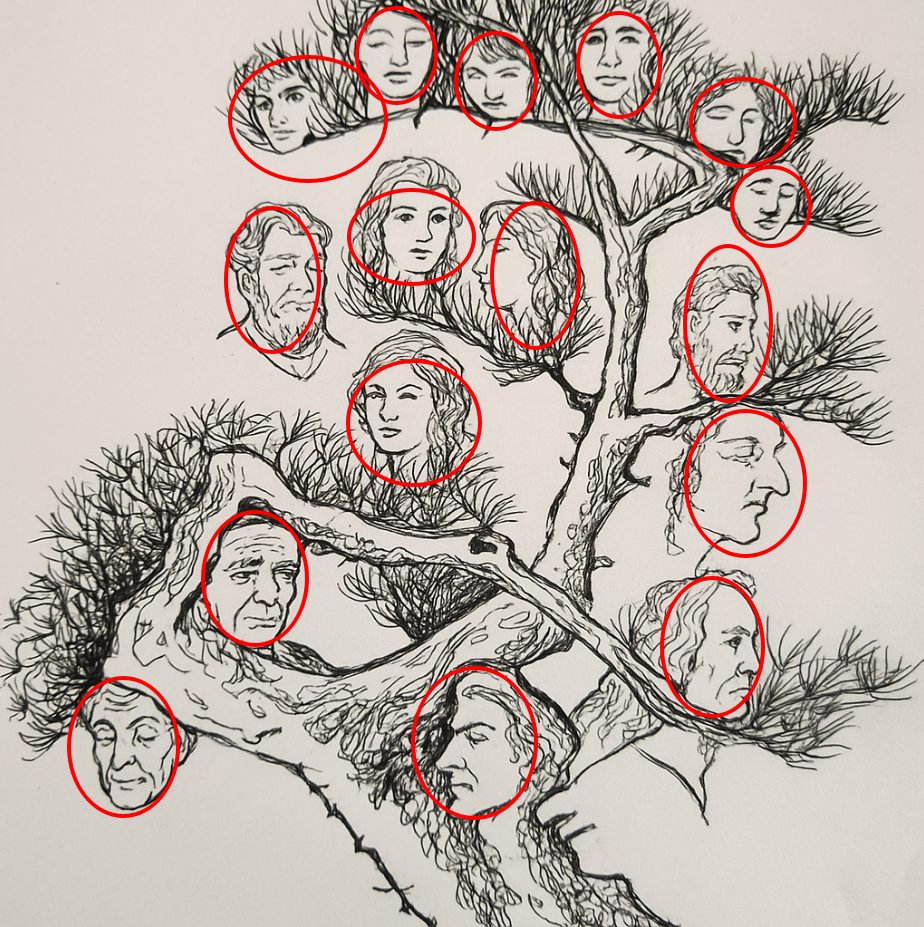The Tree of Faces: Unveiling the Mystery of Hidden Portraits in Nature-Inspired Art
A First Encounter With the Illustration
At first glance, this drawing looks like a simple tree with intricate branches and clusters of leaves. But a closer look reveals something far more intriguing: the tree is alive with human faces. Some are youthful, others older, and each one seems to carry its own expression and personality. This blending of human features with natural elements turns the picture into an optical illusion, one that invites you to pause, observe, and uncover its many hidden layers.

Why Hidden Faces Fascinate Us
Our brains are naturally drawn to faces. From the time we’re babies, we learn to recognize and connect with them. That’s why artwork like this feels so captivating—it challenges our perception by hiding familiar features in unexpected places. What looks like an ordinary branch at first might suddenly shift into the outline of a jaw or a forehead. Each discovery sparks curiosity and excitement, almost like finding a secret that was waiting just for you.
The Symbolism of the Tree and Its Faces
This illustration isn’t just about clever design—it also carries deeper meaning. The tree, a universal symbol of life and growth, merges with human faces, suggesting a connection between nature and humanity. It could represent family heritage, with the tree symbolizing ancestry and the faces acting as generations. It might also reflect the idea that we’re all rooted in the same source, our lives intertwined like the branches of a tree. Whatever interpretation you choose, the image feels both poetic and profound.

The Diversity of Expressions Hidden in the Branches
Take a closer look, and you’ll notice the range of emotions etched into these faces. Some appear calm and reflective, others serious, and a few even look weary with age. This variety adds depth to the drawing, almost as if the tree is holding the wisdom, memories, and emotions of countless individuals. It’s not just about spotting the faces—it’s about noticing how each one tells a different story.
The Psychology Behind Optical Illusions
Why do we enjoy art that tricks our eyes? It’s because illusions play with our brain’s natural tendencies. We’re wired to find meaning, to recognize shapes and patterns, even when they’re hidden. This phenomenon, called pareidolia, explains why we see animals in clouds or faces in tree bark. Art like this taps into that instinct, giving us the thrill of discovery and the satisfaction of solving a visual puzzle.

How to Explore Hidden Object Art More Effectively
If you want to enjoy illustrations like this one to the fullest, it helps to take your time. Start by scanning the entire image to understand the composition. Then focus on one section at a time, tracing the lines of the branches and leaves. Look for unusual curves or shadows—these often turn into hidden features. And don’t rush; the longer you look, the more you’ll find. Sometimes stepping back and returning later helps you notice details you missed before.
The Benefits of Engaging With Puzzles Like This
Beyond being fun, hidden object art has surprising benefits. For children, it sharpens observation skills, boosts attention span, and improves visual memory. For adults, it offers a relaxing yet stimulating mental exercise. In a world full of distractions, focusing on a detailed puzzle like this encourages mindfulness. It’s a moment of slowing down, where the only goal is to notice what’s right in front of you.

A Story Waiting to Be Told
What makes this piece even more fascinating is its narrative potential. Who are these faces? Are they ancestors, spirits, or simply symbolic characters? Are they watching over the tree, or are they part of it? The ambiguity invites viewers to create their own story, turning the artwork into an interactive experience. Each face feels like a character with a past, and together they form a living tapestry within the branches.
Why We Keep Coming Back to Hidden Art
Part of the appeal of illustrations like this is their replay value. You can look at them again and again, and each time you’ll spot something new. Maybe you missed a face before, or maybe the expression of one seems to change depending on your perspective. That’s what makes this type of art so timeless—it never feels finished, because discovery is always part of the experience.

Conclusion: The Beauty of Looking Deeper
This tree of faces is more than a drawing—it’s a visual journey that blends art, psychology, and symbolism. At first, it may look like nothing more than branches and leaves. But the longer you look, the more you uncover: faces with stories, expressions with emotions, and meanings that tie humanity to nature. It’s a reminder that life itself is full of hidden layers, waiting to be seen by those willing to look closer. Just like this artwork, the beauty often lies not in what we see first, but in what we discover when we take our time.